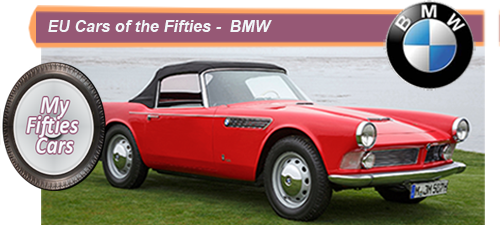
BMW, or the Bayerischen Motoren Werke (Bavarian Motor Works) to give the company their full title, began to produce cars in 1922 as an offshoot of the Bayerische Flugzeugwerke (Bavarian Aircraft Factory) established six years earlier by gifted engineer Karl Friedrich Rapp.
The underlying reason for the founding of the car production division was that after Germany was defeated in World War One, as part of the terms of the surrender agreement.
BAF was disallowed from producing any form of military equipment, instead concentrating their considerable production facilities on motorcycles, motor vehicles as well as marine engines.
During the financial and political instability of the immediate post-war years, ownership at BMW changed hands just a few years after the company was established.
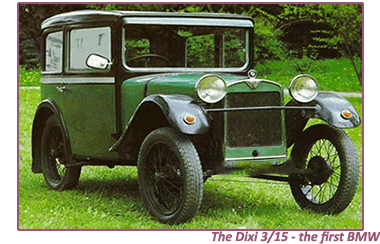 The founder, Karl Friedrich Rapp, was bought out by his former business manager, Franz-Josef Popp, with the semi-hostile takeover financed by Camillo Castiglioni, a close personal friend of Popp as well as being one of the top financiers in Vienna, their home town.
The founder, Karl Friedrich Rapp, was bought out by his former business manager, Franz-Josef Popp, with the semi-hostile takeover financed by Camillo Castiglioni, a close personal friend of Popp as well as being one of the top financiers in Vienna, their home town.
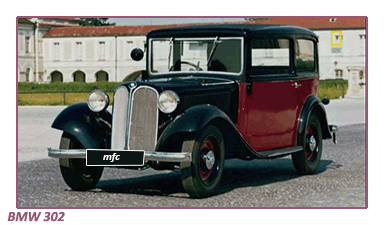 Castiglioni. like Popp, was a native of Vienna.
Castiglioni. like Popp, was a native of Vienna.
With sales of their products, in particular, their motorcycles, going along smoothly, in 1928, BMW acquired the firm of Dixi, at that time the third largest car manufacturer in Germany.
Dixi was particularly attractive to Castiglioni and Popp as the company had only recently signed an agreement with Austin of England to manufacture their entry-level Model 7 for the European market.The Dixi factory, based in Eisenach in the central region of Thuringia, had considerable production facilities at their disposal along with a well trained workforce of around 1200.
![]()
BMW wasted little time in dropping the Austin 7 title, naming their new model the Dixi which , upon release in 1928, became the company's first production car.
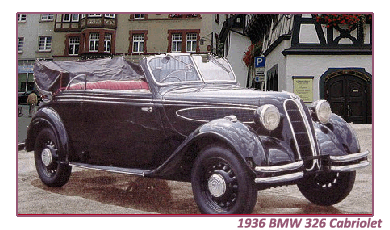 The original Dixis were powered by a 743cc four-cylinder engine capable of producing 15 horsepower.
The original Dixis were powered by a 743cc four-cylinder engine capable of producing 15 horsepower.
The following year, BMW released an updated version of the Dixi, the DA/2. Among the improvements and innovations that the new version boasted were an all-steel body and 4-wheel brakes.
Over the next three years, BMW sold a total of 16,000 Dixis. In 1932, the company released a new model, the imaginatively titled 3/20PS.
The 3/20PS was powered by a 782cc four-cylinder engine, capable of generating a respectable 20 horsepower, capable of reaching a top speed of 50 mph (80 k/ph).
 The BMW 3/20PS was a trendsetter in many ways- one of them being that it was the first car that was developed in its entirety by the company in their recently opened production center in Munich.
The BMW 3/20PS was a trendsetter in many ways- one of them being that it was the first car that was developed in its entirety by the company in their recently opened production center in Munich.
The BMW 303 was also the first to be adorned by the trademark twin-kidney shaped radiator grilles, a design feature that would figure in many BMW models over the years.
![]()
During the early Thirties, BMW was on a major production expansion drive, across all their divisions, including their reconstituted aero engine unit.
In 1934 their car production unit was in full swing, releasing the first fully-fledged BMW roadster, the 315/1. The BMW 315/1 was a far cry from its box-like predecessors, boasting a breathtakingly sleek design that was many years ahead of its time.
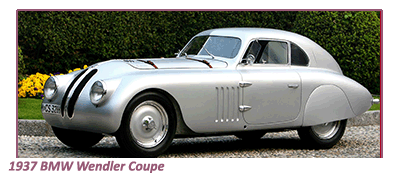 Powered by a 1.5 liter 6 cylinder engine, capable of developing 40bhp, the lightweight 315/1 could hit top speeds of around 75 mph (125km/h) making it one of the fastest cars of its time, and a star of the many Autobahns that were springing up all over Germany.
Powered by a 1.5 liter 6 cylinder engine, capable of developing 40bhp, the lightweight 315/1 could hit top speeds of around 75 mph (125km/h) making it one of the fastest cars of its time, and a star of the many Autobahns that were springing up all over Germany.
The following years leading up to the outbreak of World War Two were a time of many developments for BMW, beginning with the release of the 326 in 1934, the first from the company available as a saloon, a two-door or four-door convertible
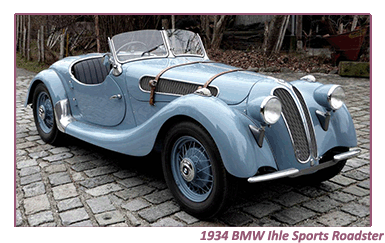 Next to come from the creative design studio at BMW was the breath taking 328 roadster, released in 1936. The 328 is regarded by classic car connoisseurs as one of the most beautiful cars ever released by BMW, certainly during the pre-war period.
Next to come from the creative design studio at BMW was the breath taking 328 roadster, released in 1936. The 328 is regarded by classic car connoisseurs as one of the most beautiful cars ever released by BMW, certainly during the pre-war period.
To add drama to the occasion, BMW unveiled the 328 to German public with at the famous and imposing banked racetrack in Nürburgring.
Following on from the BMW 132 and the Bramo engines, series production of the BMW 801 aircraft engine starts in 1940.
By the end of the war, over 20,000 of these 14-cylinder double radial engines were produced in BMW plants Munich, Allah, Berlin, and Dürrerhof, all fitted with an early form of a mechanicaly driven computer to carry out automatic tuning.
As the dust settled at the end of the World War, it emerges that almost all of BMW’s production facilities had been all but destroyed.
The Allied administration imposed a three-year ban on production due to BMW’s continued involvement in developing rocket engines, which had wreaked tremendous havoc on mainland Britain.
To provide employment and help rebuild the West German economy, BMW was awarded a number of contracts to carry out repairs on US army vehicles in their plant at Allach, the only plant that was in any way functional.
![]()
Eventually, BMW was allowed to branch out into other forms of production, producing spare parts for bicycles and farm equipment.
The original BMW car plant in Eisenach was the first to get back into production, initially building cars for the Soviet army.In 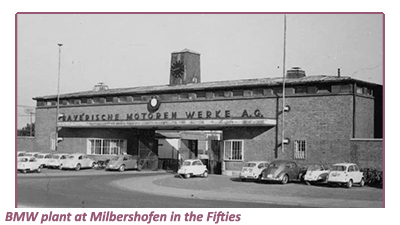 1951 the first BMWs for the domestic market began to slowly trundle off the production line, marketed however as EMWs ( an abbreviation of Eisenacher Motorenwerke) is introduced. Finance for the plant came from a Russian joint-stock company, Awtowelo.
1951 the first BMWs for the domestic market began to slowly trundle off the production line, marketed however as EMWs ( an abbreviation of Eisenacher Motorenwerke) is introduced. Finance for the plant came from a Russian joint-stock company, Awtowelo.
The Soviet Union were quick to nationalize the new/old company which would evolve to become the 'Wartburg' car brand.
In 1951 BMW released their first post-war car model, the V8 engined 501 sedans.
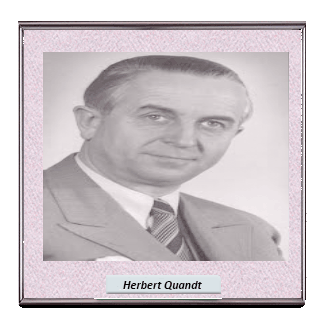 Lacking any form of aesthetic appeal, the 501 was a workhorse that failed to catch the imagination of the cash-strapped West German public. In 1954 BMW released the. 502, again an unattractive workhorse, although more economical as it was powered by a V8 light-alloy engine, the first in the World.
Lacking any form of aesthetic appeal, the 501 was a workhorse that failed to catch the imagination of the cash-strapped West German public. In 1954 BMW released the. 502, again an unattractive workhorse, although more economical as it was powered by a V8 light-alloy engine, the first in the World.
By the mid- Fifties BMW were entirely autonomous, although still struggling to establish some brand identity. In 1955 they raised a few eyebrows with the release of the Isetta, known as a “ bubble car,” little more than a three-wheel motorcycle.
A f ar cry from the gas-heavy and ponderous 501 and 502, the Isetta proved to be tremendously popular.
ar cry from the gas-heavy and ponderous 501 and 502, the Isetta proved to be tremendously popular.
With more than 150,000 sold over the next five years, the Isetta was by far and away BMW’s best selling car in the Fifties, virtually putting them back on the map.
The knock-on effect of the financial damage of the poor sales performance of the 501 and 502s, coupled with a dramatic drop in demand for motorcycles, meant that by the end of the Fifties, BMW found themselves tottering on the brink of bankruptcy.
 The company were on the verge of being swallowed up at a knockdown price,by the massive Daimler-Benz group. Rescue came in the brink off time in the form of West German financier Herbert Quandt who Quandt stepped in and acquired a large block of shares in BMW shares.
The company were on the verge of being swallowed up at a knockdown price,by the massive Daimler-Benz group. Rescue came in the brink off time in the form of West German financier Herbert Quandt who Quandt stepped in and acquired a large block of shares in BMW shares.
Quandt’s willingness to invest in BMW and to guide the company into the future inspired confidence in the markets, and the company was able to retain its independence going into the Sixties.
EU6


